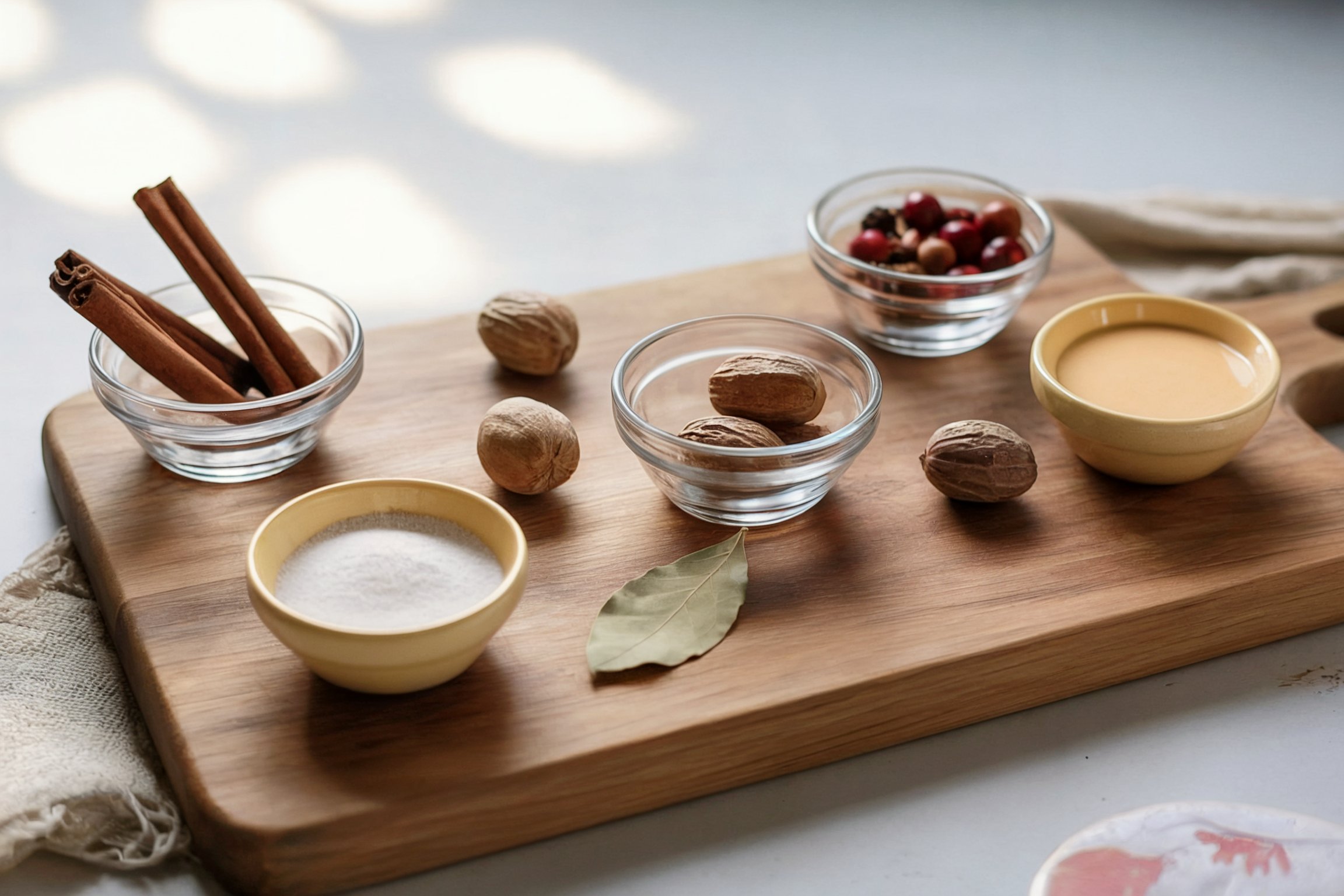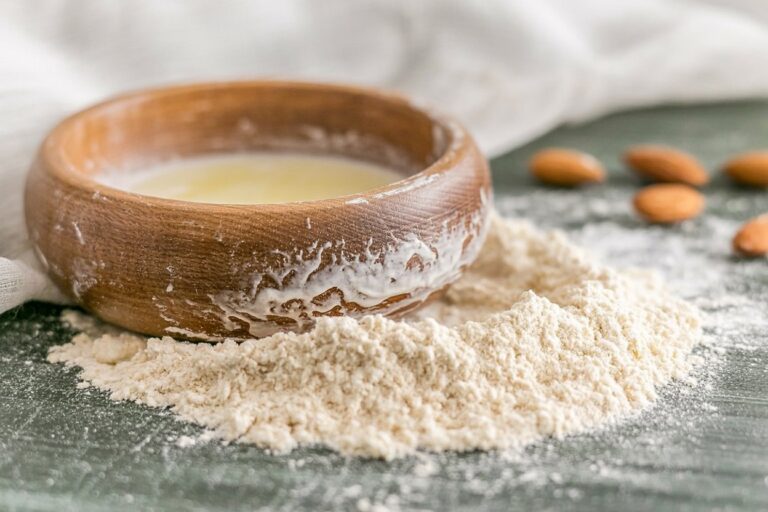Traditional Yule Cookies with Cinnamon, Nutmeg, and Bay Leaf for Solstice Prosperity Magic
Please note that posts on this site may contain affiliate links
You’re standing in a warm kitchen making cookies while the world outside reaches its darkest point. Winter solstice connects two things: heat changing raw ingredients into food that lasts, and light starting its return after the longest night. The spices used in Yule cookies (cinnamon, nutmeg, allspice) were expensive trade goods. Baking with them signaled abundance when you could afford it.
This recipe produces butter cookies with prosperity spices, meant for winter solstice baking between December 20-25. The cookies keep for two weeks in an airtight container, making them practical for gifting during the season when light returns.
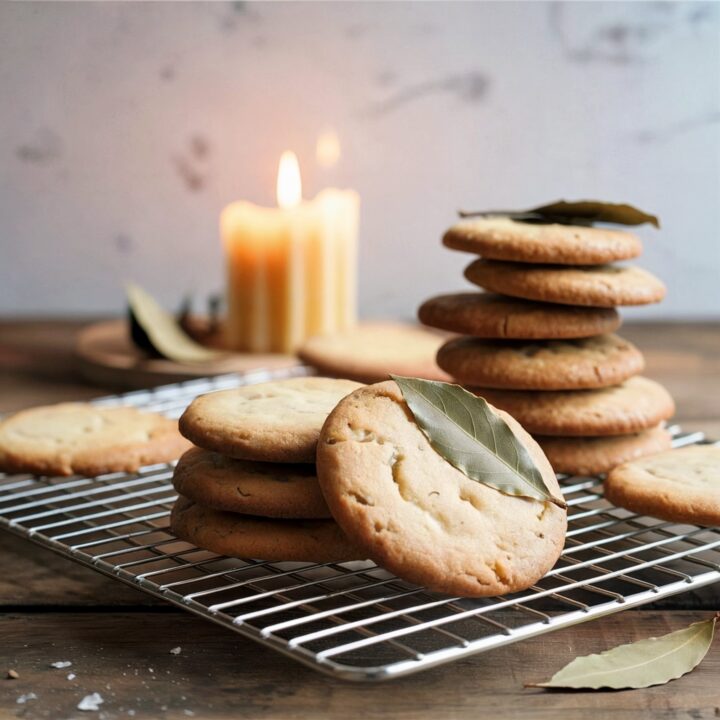
Traditional Yule Prosperity Cookies
Traditional Yule butter cookies with cinnamon, nutmeg, and allspice. Easy winter solstice recipe that keeps for 2 weeks. Includes bay leaf wish tradition for gifting. Ready in under 2 hours.
Ingredients
Dry ingredients
- 2 cups all-purpose flour
- 1½ teaspoons ground cinnamon
- ½ teaspoon ground nutmeg
- ¼ teaspoon ground allspice
- ¼ teaspoon salt
Wet ingredients
- 1 cup unsalted butter, softened to room temperature
- ¾ cup granulated sugar
- 1 large egg
- 1 teaspoon vanilla extract
Optional decoration
- Coarse sugar for rolling
- Whole bay leaves (1 per cookie if gifting)
Instructions
- Mix dry ingredients. Whisk flour, cinnamon, nutmeg, allspice, and salt together in a medium bowl until the spices distribute evenly throughout the flour. The color shifts to light tan when properly mixed.
- Cream butter and sugar. Beat softened butter and sugar together in a large bowl with an electric mixer on medium speed for 3-4 minutes. The mixture turns pale yellow and fluffy. Scrape down the sides of the bowl halfway through.
- Add egg and vanilla. Beat the egg and vanilla extract into the butter mixture on medium speed until fully incorporated, about 1 minute. The batter becomes smooth and slightly glossy.
- Combine wet and dry ingredients. Add the flour mixture to the wet ingredients in three additions, mixing on low speed after each addition until just combined. Stop mixing when no dry flour remains visible. Overmixing at this stage creates tough cookies.
- Chill the dough. Divide dough in half, shape each half into a disk, wrap tightly in plastic wrap, and refrigerate for at least 1 hour. The dough needs this time to firm up for rolling and cutting. It can chill for up to 3 days if needed.
- Roll and cut. Preheat oven to 350°F. Roll chilled dough on a lightly floured surface to ¼ inch thickness. Cut into shapes using cookie cutters (traditional shapes include suns, moons, stars, trees). Transfer cut cookies to parchment-lined baking sheets, spacing them 1 inch apart.
- Optional decoration. Roll cookies in coarse sugar before baking for sparkle and slight crunch. If gifting cookies with bay leaf wishes, press one whole bay leaf gently onto each unbaked cookie so it bakes into the surface.
- Bake. Bake for 10-12 minutes until edges just begin to turn golden. Centers may look slightly underdone. Cookies firm up as they cool. Let them rest on the baking sheet for 5 minutes, then transfer to a wire rack to cool completely.
- Storage. Store in an airtight container at room temperature for up to 2 weeks. Layer cookies with parchment paper to prevent sticking if stacking.
Notes
The spice measurements create noticeable flavor without overwhelming the butter cookie base. Increase cinnamon to 2 teaspoons if you want stronger spice presence.
Chilling the dough is not optional. Warm dough spreads too much during baking and produces thin flat cookies instead of the desired thickness.
Bay leaves baked into cookies are not meant to be eaten. Recipients write wishes on the bay leaves before burning them, a traditional practice for releasing intentions during winter solstice.
Storage and Keeping
These cookies keep for two weeks in an airtight container at room temperature. The high butter content prevents them from drying out quickly. The sugar and spices act as mild preservatives. Cookies that last through the early winter weeks demonstrate the abundance principle: one effort (baking session) produces sustained results (treats for multiple weeks).
Don’t refrigerate these cookies. Cold storage changes the texture and dries them out. Room temperature storage in an airtight container works better.
Layer cookies with parchment paper if stacking to prevent them from sticking together. They may stick slightly even with parchment because of residual butter, but they’ll separate without breaking.
If bay leaves were baked in, they soften during baking but dry out again during storage. They remain firmly attached to each cookie.
Kitchen Witchcraft: Attention as the Active Ingredient
Kitchen witchcraft treats cooking as practical magic. The transformation happens through sustained attention, not elaborate ritual. You measure accurately. You mix until just combined, not longer. You watch the timer. You notice when edges turn golden.
Every step requires you to pay attention: the color shift in the flour when spices distribute, the texture change from grainy to fluffy when creaming butter, the moment dough firms up enough to roll. These aren’t decorative observations. They’re the actual skill that determines whether cookies turn out or don’t.
When you give these cookies away, you’re giving something you made through that sustained attention. The work of transformation is the attention you brought to each step, the time you spent watching and adjusting, the skill you built through repetition.
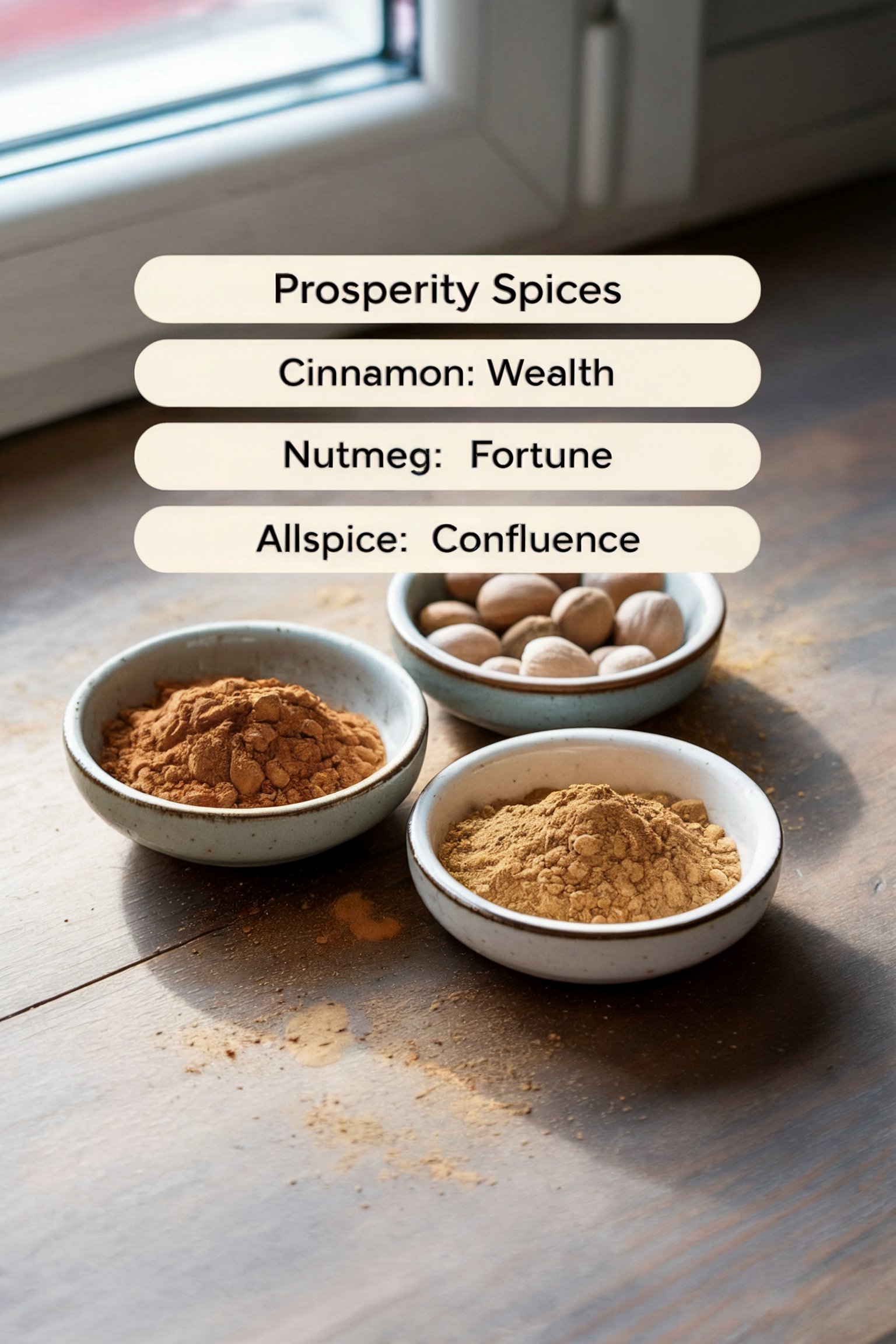
Spice History: Why These Ingredients Mean Prosperity
The herbs traditionally used in Yule celebrations carry meaning from both their physical properties and their historical value.
Cinnamon: Traded Wealth
Cinnamon is inner tree bark from Cinnamomum trees native to Sri Lanka. Someone peels it off young branches and it curls into tight scrolls as it dries. Break a stick open and the smell hits you: sweet, sharp, almost burning. That’s cinnamaldehyde, the compound that makes up 60-90% of the bark.
Arab traders controlled the supply routes and kept the source location secret for centuries to maintain their monopoly. When you baked with cinnamon before the 20th century, you were using something that cost significant money. Cinnamon was wealth you could eat, prosperity made edible. The correspondence comes from that material reality: if you could afford imported tree bark that traveled thousands of miles, you had resources to spare.
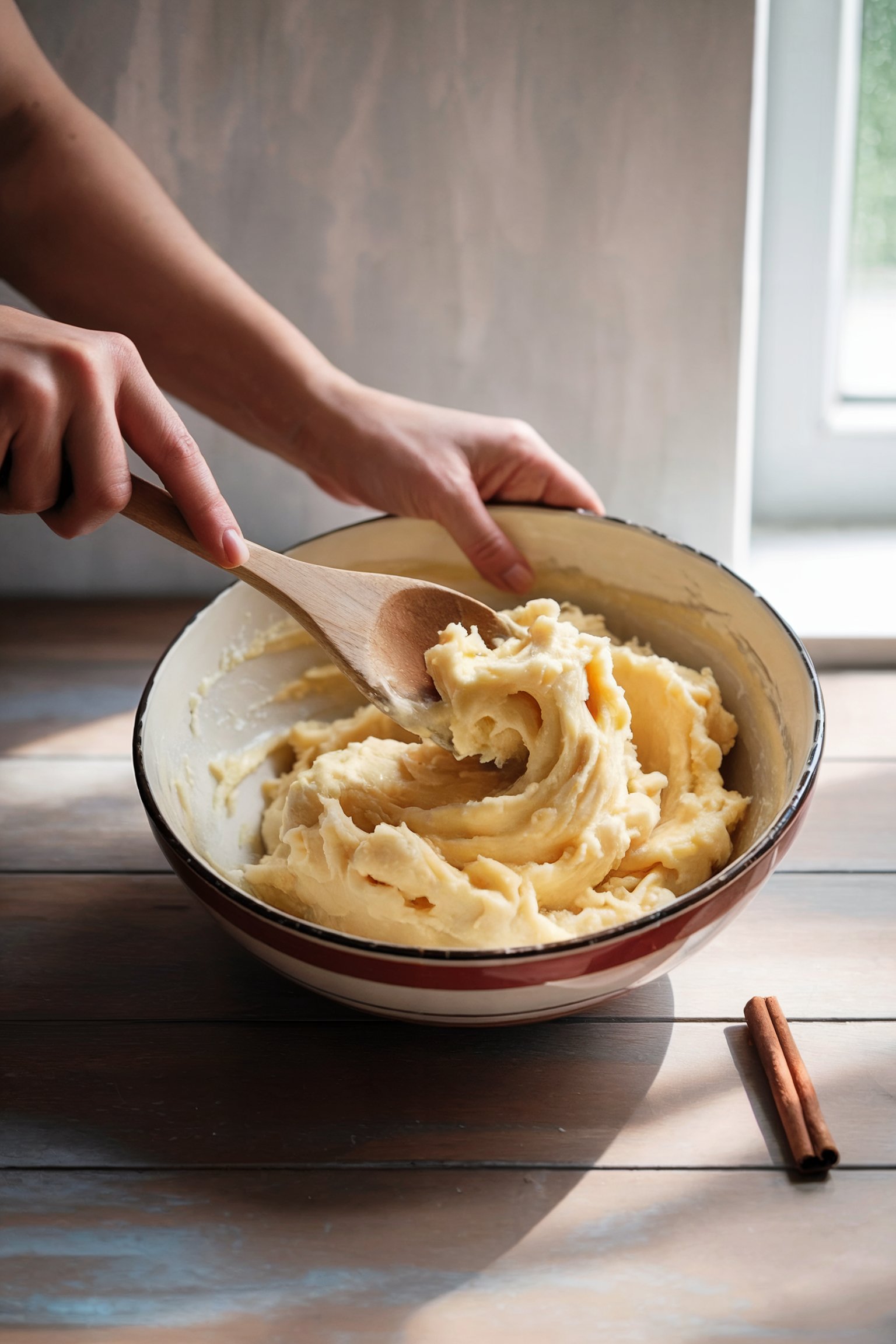
Nutmeg: Warmth Through Scarcity
Nutmeg comes from the seed of Myristica fragrans, a tree native to the Banda Islands in Indonesia. Dutch and Portuguese traders fought actual wars over control of the islands. People died for nutmeg. In 15th century Europe, a pound could cost more than livestock.
The prosperity here is about survival through winter, not display of wealth. Nutmeg’s warming quality isn’t metaphorical. The compounds literally create a sensation of internal warmth when consumed. Prosperity magic for winter focuses on having enough warmth and sustenance to survive the dark months. Using nutmeg in solstice baking connects to that specific kind of abundance: the resources that keep you warm when it’s cold outside.
Allspice: Multiplication from Single Source
Allspice is the dried unripe berry of Pimenta dioica, native to the Caribbean and Central America. It’s called allspice because it tastes like cinnamon, nutmeg, and cloves combined in a single berry. Multiple expensive flavors from one source.
This is the prosperity of multiplication. A mature allspice tree drops hundreds of pounds of berries annually. One tree producing more than you can use, year after year. Where cinnamon represents wealth through trade and nutmeg represents sustenance through scarcity, allspice represents the kind of prosperity where one source yields abundance continuously. Stand under an allspice tree during harvest and you’re swimming in spice.
Cinnamon also has preservative properties. Food prepared with it spoils more slowly. Prosperity that lasts beyond the initial abundance.
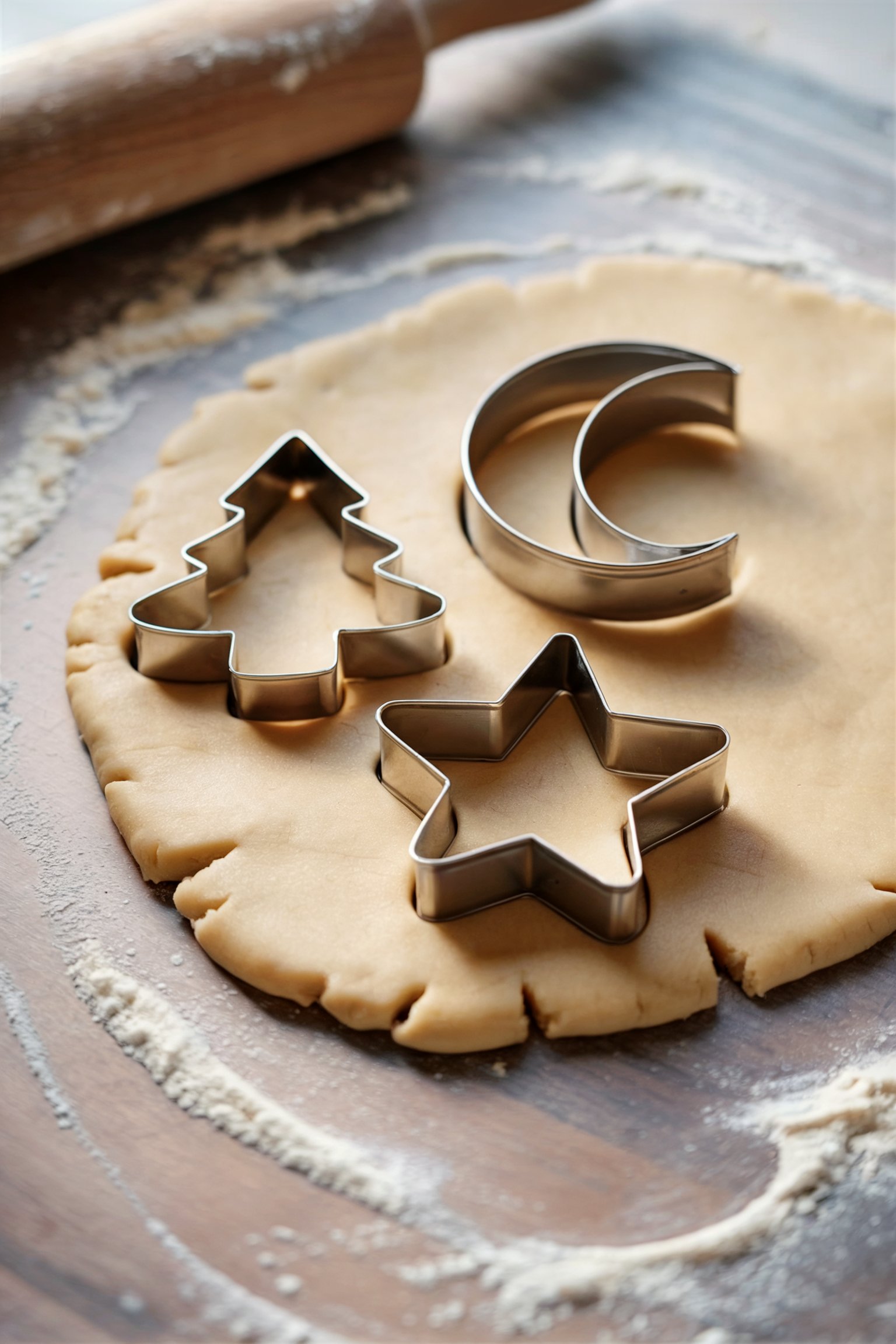
Gifting Yule Cookies as Prosperity Magic
Bay leaf wishes: Bake one whole bay leaf onto each cookie before gifting. The recipient writes a wish or intention on the bay leaf, then burns it to release the wish. This gives your gift a second function beyond being eaten. The cookie sustains physically, the bay leaf provides a small ritual action for winter solstice. Fresh bay leaves work better than old dried ones because they’re more pliable and less likely to shatter when someone writes on them.
Timing for giving: Gifts given during the three days around winter solstice (December 20-23) carry the symbolism of providing sustenance at the darkest time. You made something sweet when the world is cold. Practical help during difficult timing, not just symbolic gesture.
Packaging matters: Cookies in cheap plastic containers signal leftover disposal. Cookies in nice tins or wrapped in natural materials (muslin bags, parchment paper tied with twine) signal something you made with attention for someone specific. The container communicates value. If prosperity magic focuses on material worth, the presentation needs to match.
Quantity: Give odd numbers. Three, five, seven, nine cookies per person. Odd numbers are traditional in ceremonial practice and create better visual presentation than even numbers when arranging on a plate.
Who receives them: Prosperity magic works by circulating abundance. Give cookies to people who fed you this year. Literally fed you, or metaphorically: people who shared knowledge, created opportunities, kept you going. The exchange says this channel stays open. More coming.
The Astronomical Reality of Winter Solstice
The sun reaches its lowest point on December 21 or 22 (varies by year). Night lasts longer than any other night. You can measure this: the sun sits 23.5 degrees below the celestial equator at its lowest declination. Then light returns.
The change is small but consistent. Sunrise comes one minute earlier each day after solstice. Sunset arrives one minute later. Over the week following solstice, you gain seven minutes of daylight. By mid-January, you’ve gained 30 minutes. The increment is measurable.
Baking during this timing means you’re creating heat and transforming raw materials while the outside world sits at its actual darkest point, measured in degrees and minutes. Your oven contradicts the astronomical reality. The kitchen fills with warm spice smells and golden light. You’re producing food that will last two weeks at the moment when daylight is shortest and resources historically ran lowest.
This is why the timing matters. You’re baking at the hinge point between decreasing and increasing light.
Pair these cookies with warm spiced wassail or serve them at winter solstice gatherings while watching seasonal films by candlelight.
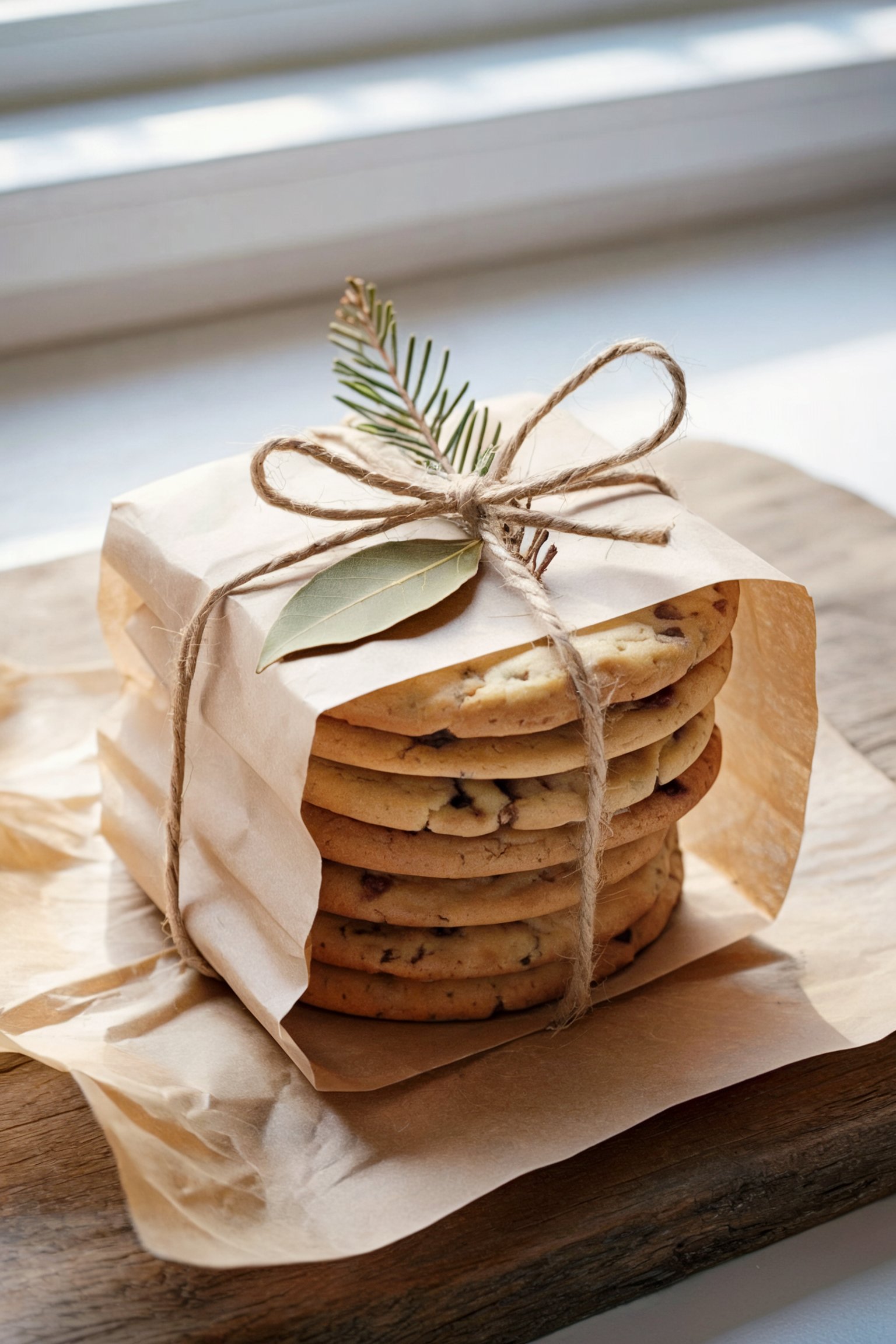
What Makes This Recipe Traditional
Traditional Yule cookie recipes across Northern European cultures use butter, warming spices, and simple shapes. The specific spice blend here (cinnamon, nutmeg, allspice) reflects Caribbean and East Asian trade routes that brought these ingredients to Europe, so “traditional” means “commonly used for the past 400 years,” not ancient.
The butter cookie base appears in German Zimtsterne, Scottish shortbread variations, and Scandinavian pepparkakor with slight modifications. This version uses American measurements and modern oven temperatures, but the ratio of butter to flour to sugar and the spice profile match historical recipes.
What makes cookies specifically for Yule rather than generic winter cookies is the timing and intention. Baking them during the three days around winter solstice ties them to the light’s return. Using expensive spices connects to historical demonstrations of wealth during the season when resources ran low. The combination of timing, ingredients, and intention creates seasonal specificity.
The bay leaf wish tradition appears in multiple cultures’ winter solstice practices. Writing wishes and burning them to release intentions works across Greek, Roman, and modern folk magic traditions. Adding this element to cookie gifting turns simple baking into a prosperity practice with participatory ritual component for recipients.
Try other winter cookie recipes:
- Ginger Snap Cookies for Yule
- Christmas Ooey Gooey Butter Cookies
- Kitchen Sink Cookies
- Modern Qullupu Cookies
- Full Moon Crescent Cookies
The astrological correspondences of these traditional herbs and spices add another layer of meaning to winter baking, connecting planetary energies to the warming spices that make these cookies special.
Looking Ahead: Cookies for the Next Wheel Turn
As winter wanes and spring approaches, these same butter cookie techniques adapt beautifully to Ostara celebrations. The wheel of the year keeps turning, and cookies for the spring equinox carry different energies: rebirth, new growth, the return of green things. Where Yule cookies use warming winter spices and focus on endurance through darkness, spring cookies incorporate lighter flavors like lemon, lavender, and fresh herbs that honor the season’s quickening energy. Same basic recipe, different seasonal intention. The cycle continues.

